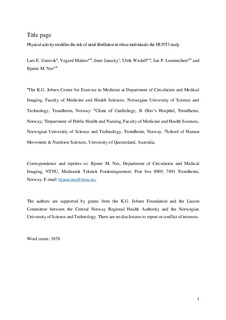Physical activity modifies the risk of atrial fibrillation in obese individuals: The HUNT3 study
Journal article, Peer reviewed
Accepted version
Permanent lenke
http://hdl.handle.net/11250/2586475Utgivelsesdato
2018Metadata
Vis full innførselSamlinger
Originalversjon
European Journal of Preventive Cardiology. 2018, 25 (15), 1646-1652. 10.1177/2047487318784365Sammendrag
Background
Atrial fibrillation is the most common heart rhythm disorder, and high body mass index is a well-established risk factor for atrial fibrillation. The objective of this study was to examine the associations of physical activity and body mass index and risk of atrial fibrillation, and the modifying role of physical activity on the association between body mass index and atrial fibrillation.
Design
The design was a prospective cohort study.
Methods
This study followed 43,602 men and women from the HUNT3 study in 2006–2008 until first atrial fibrillation diagnosis or end of follow-up in 2015. Atrial fibrillation diagnoses were collected from hospital registers and validated by medical doctors. Cox proportional hazard regression analysis was performed to assess the association between physical activity, body mass index and atrial fibrillation.
Results
During a mean follow-up of 8.1 years (352,770 person-years), 1459 cases of atrial fibrillation were detected (4.1 events per 1000 person-years). Increasing levels of physical activity were associated with gradually lower risk of atrial fibrillation (p trend 0.069). Overweight and obesity were associated with an 18% (hazard ratio 1.18, 95% confidence interval 1.03–1.35) and 59% (hazard ratio 1.59, 95% confidence interval 1.37–1.84) increased risk of atrial fibrillation, respectively. High levels of physical activity attenuated some of the higher atrial fibrillation risk in obese individuals (hazard ratio 1.53, 95% confidence interval 1.03–2.28 in active and 1.96, 95% confidence interval 1.44–2.67 in inactive) compared to normal weight active individuals.
Conclusion
Overweight and obesity were associated with increased risk of atrial fibrillation. Physical activity offsets some, but not all, atrial fibrillation risk associated with obesity.
